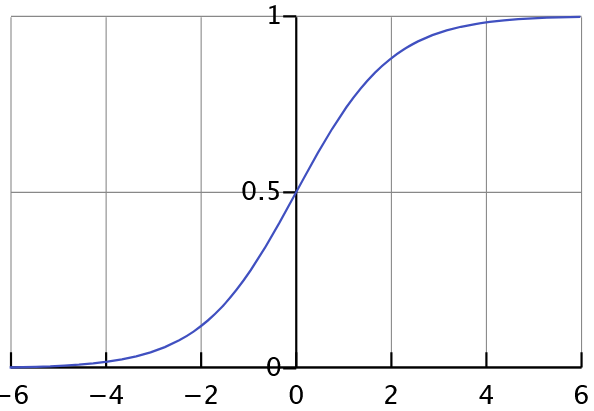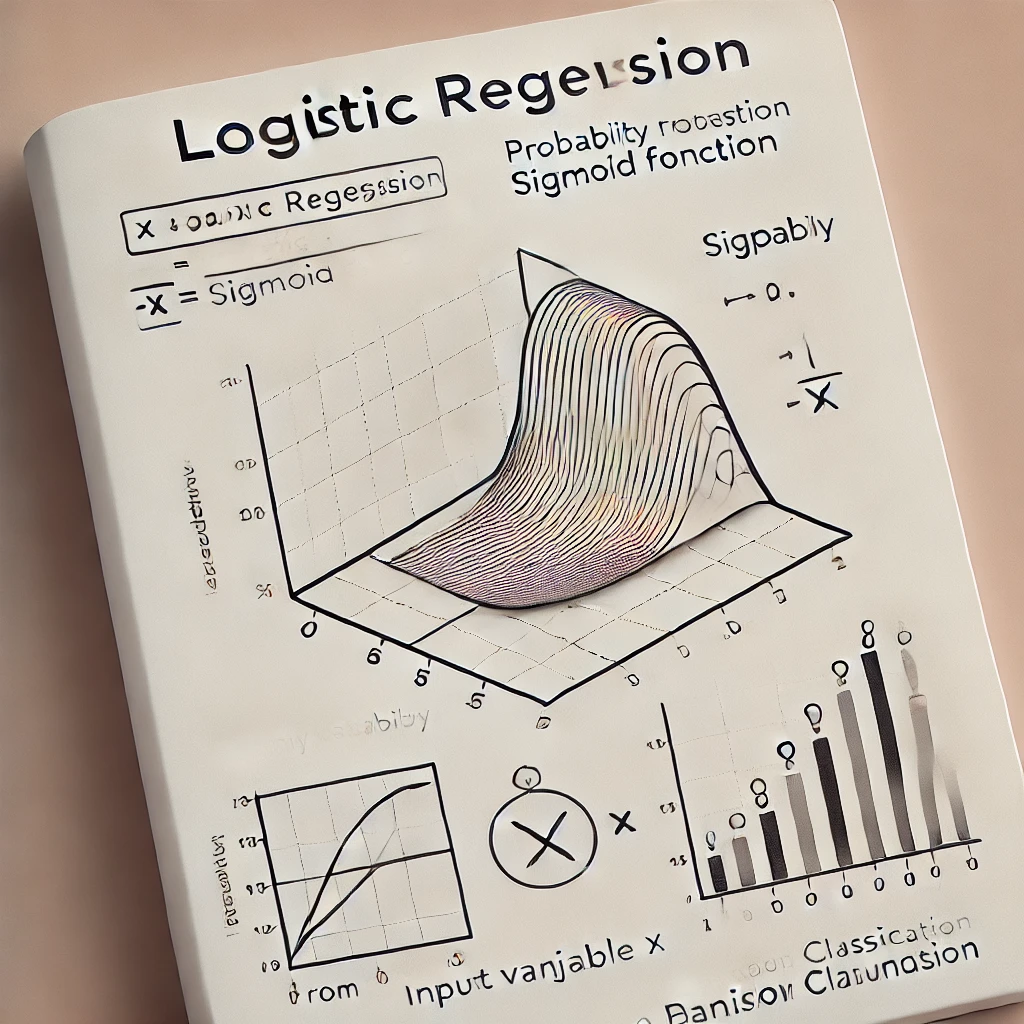這是給自己的一份學習紀錄,以免日子久了忘記這是甚麼理論XD
Logistic Function (aka logit, MaxEnt) classifier, which means that it is also known as logit regression,
maximum-entropy classification(MaxEnt) or the log-linear classifier.
In this model, the probabilities from the outcome of predictions is using a logistic function.
And what is logistic function?
Let talk about it.
Here comes from Wikipedia:
A logistic function or a logistic curve is a commond S-shaped curve (sigmoid curve) with the equation: $$ f(x) = \frac{L}{1+e^{-k(x-x_o)}}$$ where:
- $L$ is the supremum of the values of the function
- $k$ is the logistic growth rate, the steepness of the curve
- $x_0$ is the $x$ value of the function’s midpoint
中譯:
- $L$ 是該函數(系統)一個最大上限,當 $x \to 0$ 時,則 $ f(x) \to L$
- $k$ 該曲線的陡峭程度,$k$ 愈小則分母愈大,整個 $f(x)$愈小,表示中間變化速度緩慢;反之則中間變化速度快
- $x_0$ 曲線當中變化速度最快的一點
我們可以簡化該方程式:
The standard logistic function, where $L=1, k=1, x_0=0$, has the euqation: $$ f(x) = \frac{1}{1+e^{-x}}$$
and is also called sigmoid function, and it looks like:
 We can know that:
We can know that:
- When $x=0, f(0)= \frac{1}{2}$
- When $x=\infty, f(\infty)= 1$
- When $x=-\infty, f(-\infty)=0$
Therefore, we use this function because the logistic function ranges between 0 and 1 and is relatively simple among smooth functions
But how does logistic regression find the best estimators for making predictions?
Here is the process
1. Target
We suppose that: $$ f(X) = P(Y=1 \mid X) = \frac{1}{1+e^{-(W^TX)}} $$ and we should know that:
$$ P(Y\mid X) = f(X) \text{if } Y=1 $$
$$ P(Y\mid X) = 1 - f(X) \text{if } Y=0 $$
2. How to
Logistic regression uses the likelihood function to estimate parameters, allowing the model to make more precise predictions. So we define likelihood function: $$ L(W, b) = \Pi^n_{i=1}P\left(y_i \mid x_i \right) $$
3. Mathematical
Then we plug $P(Y\mid X)$ into the formula, so we have: $$ L(W, b) = \Pi^n_{i=1}\left(\frac{1}{1+e^{-(W^TX)}}\right)^{y_i}\left(1-\frac{1}{1+e^{-(W^TX)}}\right)^{1- y_i} $$ and we take the log of likelihood function(log-likelihood): $$ lnL(W, b) = \Sigma^n_{i=1}\left[y_iln\left(\frac{1}{1+e^{-(W^TX)}}\right)\right] + (1- y_i)ln\left(1-\frac{1}{1+e^{-(W^TX)}}\right)$$
then we use calculus and gradient descent to find the optimal parameter W. Finally, we ensure that the likelihood function reaches its maximum, which corresponds to the MLE solution.
In my opinion
It is easy to see that using linear regression for predicting or classifying binary classes can be highly influenced by outliers.
A small change in the data can cause a data point to switch from Class 1 to Class 2 unpredictably, which is unreasonable.
To address this issue and improve the regression model for binary classification, we use a logistic function that better fits the binary class data.
🔧 Modeling with sklearn.LogisticRegression
import pandas as pd
import seaborn as sns
import numpy as np
import matplotlib.pyplot as plt
coloumns_name = ['Length', 'Left', 'Right', 'Bottom', 'Top', 'Diagonal']
data = pd.read_csv('bank2.dat', delim_whitespace=True, header=None, names=coloumns_name)
data.head()
--------------------------------------------------
Length Left Right Bottom Top Diagonal Class
0 214.8 131.0 131.1 9.0 9.7 141.0 Genuine
1 214.6 129.7 129.7 8.1 9.5 141.7 Genuine
2 214.8 129.7 129.7 8.7 9.6 142.2 Genuine
3 214.8 129.7 129.6 7.5 10.4 142.0 Genuine
4 215.0 129.6 129.7 10.4 7.7 141.8 Genuine
data.info()
--------------------------------------------------
<class 'pandas.core.frame.DataFrame'>
RangeIndex: 200 entries, 0 to 199
Data columns (total 7 columns):
# Column Non-Null Count Dtype
--- ------ -------------- -----
0 Length 200 non-null float64
1 Left 200 non-null float64
2 Right 200 non-null float64
3 Bottom 200 non-null float64
4 Top 200 non-null float64
5 Diagonal 200 non-null float64
6 Class 200 non-null object
dtypes: float64(6), object(1)
memory usage: 11.1+ KB
data.isna().sum()
--------------------------------------------------
Length 0
Left 0
Right 0
Bottom 0
Top 0
Diagonal 0
Class 0
dtype: int64
data.describe().T
--------------------------------------------------
count mean std min 25% 50% 75% max
Length 200.0 214.8960 0.376554 213.8 214.6 214.90 215.100 216.3
Left 200.0 130.1215 0.361026 129.0 129.9 130.20 130.400 131.0
Right 200.0 129.9565 0.404072 129.0 129.7 130.00 130.225 131.1
Bottom 200.0 9.4175 1.444603 7.2 8.2 9.10 10.600 12.7
Top 200.0 10.6505 0.802947 7.7 10.1 10.60 11.200 12.3
Diagonal 200.0 140.4835 1.152266 137.8 139.5 140.45 141.500 142.4
from sklearn.model_selection import train_test_split
from sklearn.preprocessing import StandardScaler, LabelEncoder
from sklearn.linear_model import LogisticRegression
from sklearn.metrics import confusion_matrix, accuracy_score, classification_report
X = data.drop(columns=['Class'])
y = data['Class']
X_train, X_test, y_train, y_test = train_test_split(X, y, random_state=42, test_size=0.2)
scaler = StandardScaler()
X_train_scaled = scaler.fit_transform(X_train)
X_test_scaled = scaler.transform(X_test)
lr = LogisticRegression(random_state=42, penalty=None)
model = lr.fit(X_train_scaled, y_train)
y_pred = model.predict(X_test_scaled)
y_proba = model.predict_proba(X_test_scaled)
print(confusion_matrix(y_test, y_pred))
print(accuracy_score(y_test, y_pred))
--------------------------------------------------
[[19 0]
[ 1 20]]
0.975
print("\nModel Accuracy:", model.score(X_test_scaled, y_test))
print(classification_report(y_test, y_pred))
Model Accuracy: 0.975
precision recall f1-score support
Counterfeit 0.95 1.00 0.97 19
Genuine 1.00 0.95 0.98 21
accuracy 0.97 40
macro avg 0.97 0.98 0.97 40
weighted avg 0.98 0.97 0.98 40
🔨 Modleing with statsmodels.Logit
note:
因為使用該模型存在beta不收斂的問題
所以在fit的部分選擇使用fit_regularized
其中method設定加入l1懲罰, alpha(l1的權重)設0.01
summay才會正常跑出數值
constant = sm.add_constant(X)
model = sm.Logit(y, constant)
result = model.fit_regularized(method='l1', alpha=0.01)
print(result.summary())
--------------------------------------------------
Optimization terminated successfully (Exit mode 0)
Current function value: 0.002174041962487562
Iterations: 131
Function evaluations: 136
Gradient evaluations: 131
Logit Regression Results
==============================================================================
Dep. Variable: y No. Observations: 200
Model: Logit Df Residuals: 193
Method: MLE Df Model: 6
Date: Thu, 20 Mar 2025 Pseudo R-squ.: 0.9994
Time: 16:39:59 Log-Likelihood: -0.083416
converged: True LL-Null: -138.63
Covariance Type: nonrobust LLR p-value: 6.587e-57
==============================================================================
coef std err z P>|z| [0.025 0.975]
------------------------------------------------------------------------------
const 7.851e-18 1.11e+04 7.07e-22 1.000 -2.18e+04 2.18e+04
Length -4.8724 46.740 -0.104 0.917 -96.481 86.737
Left 6.129e-16 83.355 7.35e-18 1.000 -163.372 163.372
Right -6.8e-16 80.137 -8.49e-18 1.000 -157.066 157.066
Bottom -11.9135 14.936 -0.798 0.425 -41.187 17.360
Top -9.3913 15.731 -0.597 0.551 -40.224 21.441
Diagonal 8.9620 10.880 0.824 0.410 -12.362 30.286
==============================================================================
Possibly complete quasi-separation: A fraction 0.95 of observations can be
perfectly predicted. This might indicate that there is complete
quasi-separation. In this case some parameters will not be identified.
c:\Users\USER\anaconda3\Lib\site-packages\statsmodels\base\l1_solvers_common.py:71: ConvergenceWarning: QC check did not pass for 1 out of 7 parameters
Try increasing solver accuracy or number of iterations, decreasing alpha, or switch solvers
warnings.warn(message, ConvergenceWarning)
c:\Users\USER\anaconda3\Lib\site-packages\statsmodels\base\l1_solvers_common.py:144: ConvergenceWarning: Could not trim params automatically due to failed QC check. Trimming using trim_mode == 'size' will still work.
warnings.warn(msg, ConvergenceWarning)
